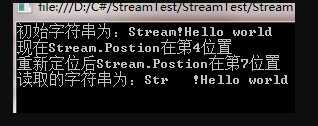关于Stream的知识分享
Posted xiaomowang
tags:
篇首语:本文由小常识网(cha138.com)小编为大家整理,主要介绍了关于Stream的知识分享相关的知识,希望对你有一定的参考价值。
一、什么是Stream
查了一下MSDN,他是这么解释的:提供字节序列的一般视图。
这个解释有点太笼统了,下面,我们来仔细的捋一下
1、什么是字节序列?
字节序列指的是:字节对象被存储为连续的字节序列,字节按照一定的顺序进行排序组成了字节序列。
那么关于流的解释可以抽象为下列情况:
一条河中有一条鱼游过,这条鱼就是一个字节,这个字节包括鱼的眼睛、嘴巴、等组成8个二进制,显然这条河就是我们的核心对象:流
下面我们来认识一下C#中的Stream是如何使用的吧。
二、Stream类的结构,属性和相关方法
1、构造函数:
Stream类有一个protected类型的构造函数,但是他是个抽象类,无法直接使用new来实例化。所以我们自定义一个流继承自Stream,看看哪些属性必须重写或自定义:
1 public class MyStreamExample : Stream 2 { 3 4 public override bool CanRead 5 { 6 get { throw new NotImplementedException(); } 7 } 8 9 public override bool CanSeek 10 { 11 get { throw new NotImplementedException(); } 12 } 13 14 public override bool CanWrite 15 { 16 get { throw new NotImplementedException(); } 17 } 18 19 public override void Flush() 20 { 21 throw new NotImplementedException(); 22 } 23 24 public override long Length 25 { 26 get { throw new NotImplementedException(); } 27 } 28 29 public override long Position 30 { 31 get 32 { 33 throw new NotImplementedException(); 34 } 35 set 36 { 37 throw new NotImplementedException(); 38 } 39 } 40 41 public override int Read(byte[] buffer, int offset, int count) 42 { 43 throw new NotImplementedException(); 44 } 45 46 public override long Seek(long offset, SeekOrigin origin) 47 { 48 throw new NotImplementedException(); 49 } 50 51 public override void SetLength(long value) 52 { 53 throw new NotImplementedException(); 54 } 55 56 public override void Write(byte[] buffer, int offset, int count) 57 { 58 throw new NotImplementedException(); 59 } 60 }
可以看出系统自动帮我们实现了Stream的抽象属性和属性方法
(1)CanRead:只读属性,判断该流是否能够读取;
(2)CanSeek:只读属性,判断该流是否支持跟踪查找;
(3)CanWrite:只读属性,判断当前流是否可写;
(4)void Flush():当我们使用流写文件时,数据流会先进入到缓冲区中,而不会立刻写入文件,当执行这个方法后,缓冲区的数据流会立即写入基础流。
(5)Length:流的长度;
(6)Position:表示流中的一个位置。
(7)abstract int Read(byte[] buffer,int offset,int count)
这个方法包含了3个关键参数:缓冲字节数组,位偏移量和读取字节个数,每次读取一个字节后会返回一个缓冲区的总字节数
第一个参数:这个数组相当于一个空盒子,Read() 方法每次读取流中的一个字节,将其放进这个空盒子中(全部读完后便可以使用buffer字节数组了)
第二个参数:表示位移偏量,告诉我们从流中哪个位置(偏移量)开始读取。
第三个参数:就是读取多少字节数。
返回值:总共读取了多少字节数
(8)abstract long Seek(long offset,SeekOrigin origin)
大家还记的Position属性吗?其实Seek方法就是从新设定流中的一个位置。在说明offset参数作用之前大家先来了解下SeekOrigin这个枚举:

如果offset为负,则要求 新位置位于origin制定的位置之前,其间隔相差offset制定的字节数。如果offset为0,则要求新位置位于由origin指定的位置处。如果offset为正,则要求新位置位于origin制定的位置后,其间隔相差offset制定的字节数。
Stream.Seek(-3,Origin.End):表示在流末端往前第3个位置。
Stream.Seek(0,Origin.Begin):表示在流的开头位置。
Stream.Seek(3,Origin.Current):表示在流的当前位置往后数第3个位置。
查找之后会返回一个流中的一个新位置,其实说到这大家就能理解Seek方法的精妙之处了吧。
(9)abstract void Write(byte[] buffer,int offset,int count)
这个方法包含3个关键参数:缓冲字节数组,位移偏量和读取字节个数和read方法,不同的是write方法中的第一个参数buffer已经有许多byte类型的数据,我们只需通过设置offset和count来将buffer中的数据写入流中。
(10)virtual void Close()
关闭流并释放资源,在实际操作中,如果不用using的话,别忘了使用完流之后将其关闭。
为了让大家能够快速理解和消化上面的属性和方法,下面,我们写个示例:
1 static void Main(string[] args) 2 { 3 byte[] buffer = null; 4 5 string testString = "Stream!Hello world"; 6 char[] readCharArray = null; 7 byte[] readBuffer = null; 8 string readString = string.Empty; 9 //关于MemoryStream 我会在后续章节详细阐述 10 using (MemoryStream stream = new MemoryStream()) 11 { 12 Console.WriteLine("初始字符串为:{0}", testString); 13 //如果该流可写 14 if (stream.CanWrite) 15 { 16 //首先我们尝试将testString写入流中 17 //关于Encoding我会在另一篇文章中详细说明,暂且通过它实现string->byte[]的转换 18 buffer = Encoding.Default.GetBytes(testString); 19 //我们从该数组的第一个位置开始写,长度为3,写完之后 stream中便有了数据 20 //对于新手来说很难理解的就是数据是什么时候写入到流中,在冗长的项目代码面前,我碰见过很 21 //多新手都会有这种经历,我希望能够用如此简单的代码让新手或者老手们在温故下基础 22 stream.Write(buffer, 0,3); 23 24 Console.WriteLine("现在Stream.Postion在第{0}位置",stream.Position+1); 25 26 //从刚才结束的位置(当前位置)往后移3位,到第7位 27 long newPositionInStream =stream.CanSeek? stream.Seek(3, SeekOrigin.Current):0; 28 29 Console.WriteLine("重新定位后Stream.Postion在第{0}位置", newPositionInStream+1); 30 if (newPositionInStream < buffer.Length) 31 { 32 //将从新位置(第7位)一直写到buffer的末尾,注意下stream已经写入了3个数据“Str” 33 stream.Write(buffer, (int)newPositionInStream, buffer.Length - (int)newPositionInStream); 34 } 35 36 37 //写完后将stream的Position属性设置成0,开始读流中的数据 38 stream.Position = 0; 39 40 // 设置一个空的盒子来接收流中的数据,长度根据stream的长度来决定 41 readBuffer = new byte[stream.Length]; 42 43 44 //设置stream总的读取数量 , 45 //注意!这时候流已经把数据读到了readBuffer中 46 int count = stream.CanRead?stream.Read(readBuffer, 0, readBuffer.Length):0; 47 48 49 //由于刚开始时我们使用加密Encoding的方式,所以我们必须解密将readBuffer转化成Char数组,这样才能重新拼接成string 50 51 //首先通过流读出的readBuffer的数据求出从相应Char的数量 52 int charCount = Encoding.Default.GetCharCount(readBuffer, 0, count); 53 //通过该Char的数量 设定一个新的readCharArray数组 54 readCharArray = new char[charCount]; 55 //Encoding 类的强悍之处就是不仅包含加密的方法,甚至将解密者都能创建出来(GetDecoder()), 56 //解密者便会将readCharArray填充(通过GetChars方法,把readBuffer 逐个转化将byte转化成char,并且按一致顺序填充到readCharArray中) 57 Encoding.Default.GetDecoder().GetChars(readBuffer, 0, count, readCharArray, 0); 58 for (int i = 0; i < readCharArray.Length; i++) 59 { 60 readString += readCharArray[i]; 61 } 62 Console.WriteLine("读取的字符串为:{0}", readString); 63 } 64 65 stream.Close(); 66 } 67 68 Console.ReadLine(); 69 70 }
结果:

好了,关于流的基本介绍和概念,我们就分享到这里。非常感谢 逆时针の风 的博客对我的帮助。
以上是关于关于Stream的知识分享的主要内容,如果未能解决你的问题,请参考以下文章